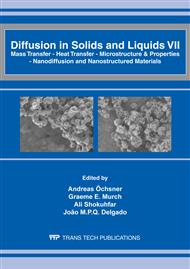p.682
p.690
p.696
p.702
p.708
p.713
p.719
p.725
p.731
Study of the Anelastic Behavior of PZT and PLZT Ferroelectric Ceramics
Abstract:
The anelastic behavior of the ferroelectric ceramics (Pb)(Zr/Ti)O3 (PZT) and (Pb/La)(Zr/Ti)O3 (PLZT), with Zr/Ti = 65/35, La = 5 at.% and 8 at.%, was investigated in the region of the ferroelectric phase transitions. Anelastic spectroscopy experiments were performed in an acoustic elastometer system, operating in a kilohertz bandwidth, at temperatures rising from 300 K to 770 K, at a heating rate of 1 K/min, under pressure of 10-5mbar. Anelastic measurements on PZT showed only one anomaly, associated with the occurrence of a ferroelectric-paraelectric phase transition, while the PLZT data showed two anomalies, which were associated with the following transitions: the ferroelectric-paraelectric phase transition and a ferro-ferroelectric phase transition between distinct rhombohedral ferroelectric phases. The behavior of the relative variation of the elastic moduli with temperature, near the phase transitions, which describes the change in the type of coupling between strain and the order parameter in ferroelectric-paraelectric phase transition, with the increase of lanthanum amount and, linear coupling in the strain and order parameter type to PZT ceramic and linear coupling in the strain but quadratic in order parameter type for PLZT ceramics.
Info:
Periodical:
Pages:
719-724
Citation:
Online since:
April 2012
Price:
Сopyright:
© 2012 Trans Tech Publications Ltd. All Rights Reserved
Share:
Citation:


